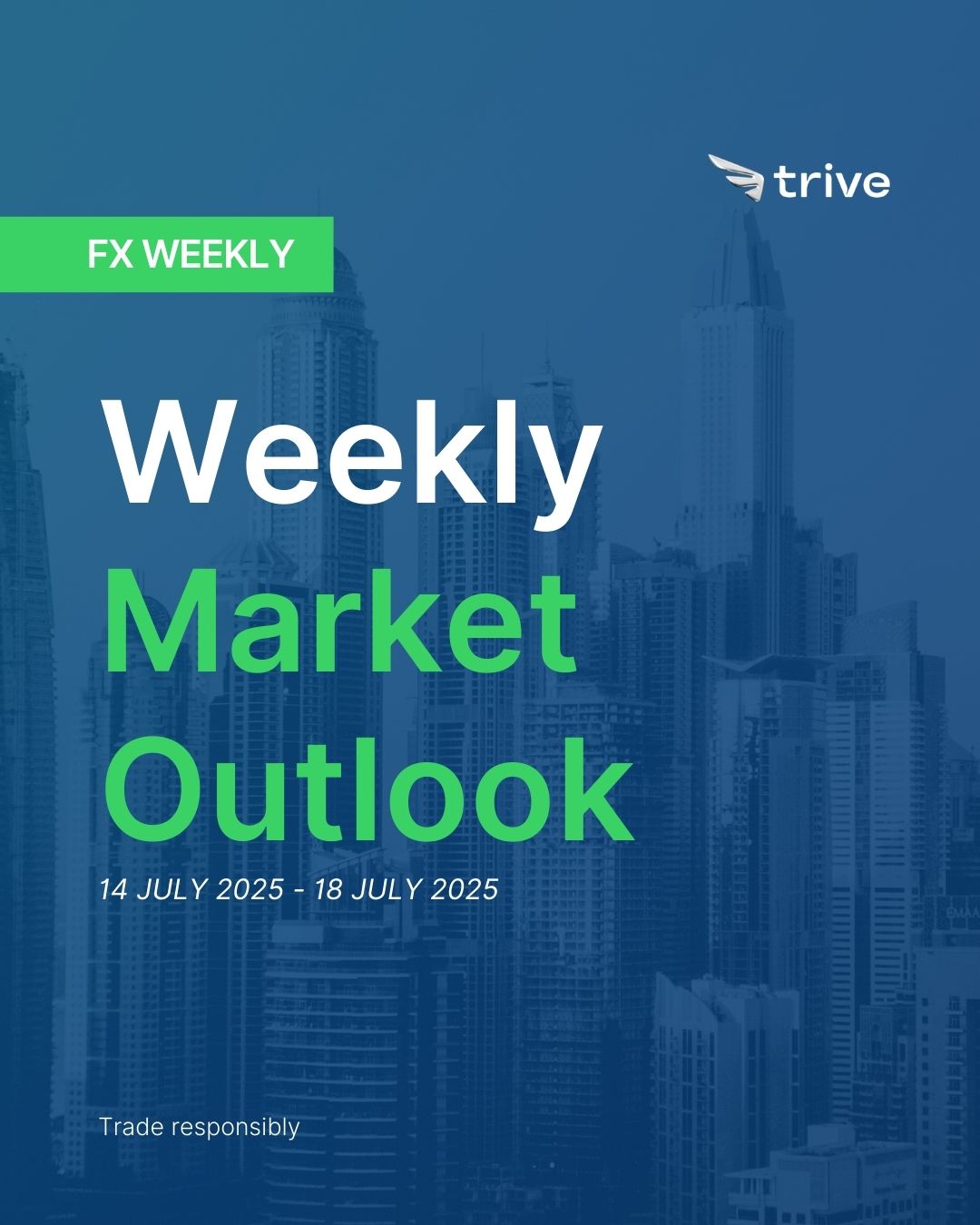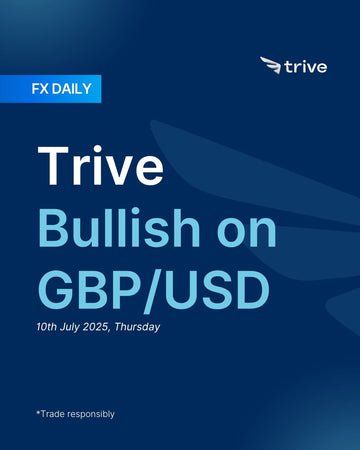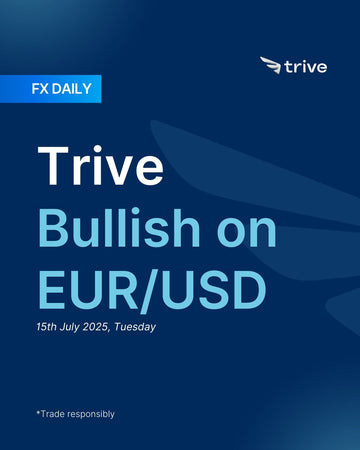FX Weekly: Trive’s Week Ahead Views

This week highlights include US CPI and Retail Sales, UK CPI and Jobs report, China trade and GDP, Aussie Jobs, and CPI from Canada and Japan.
Monday
Markets begin the week with focus on the expiration of the EU’s 90-day retaliatory tariff pause, which formally ends Monday. While no immediate reimposition of duties is expected, the end of this truce removes a diplomatic buffer in the broader US–EU trade standoff, particularly as Washington’s latest “Liberation Day” tariffs take effect this month. The lapse in pause heightens the sensitivity of EUR crosses and industrial equities to any new retaliatory measures that could follow.
Attention also turns to Asia, with India releasing June wholesale price index (WPI) data, and China publishing its June trade balance. While no official consensus is available for the Chinese figures, recent Caixin manufacturing PMIs hinted at a modest trade recovery. New orders picked up slightly on domestic demand, but new export orders fell for a third consecutive month—albeit at a slower pace. ING expects only a mild uptick in exports and imports, noting the absence of significant trade frontloading despite the ongoing US–China tariff ceasefire. Meanwhile, supply chains remain under pressure, with delivery delays reported again in June. The data will be watched closely for any early signs of decoupling between production sentiment and external demand as Beijing attempts to stabilise industrial activity.
Tuesday
Tuesday delivers a macro deluge led by Chinese Q2 GDP, retail sales, and house prices—all in sharp focus as the country confronts a slowing economy and persistent deflation risk. According to a Reuters poll, China’s Q2 GDP is expected to grow 5.1% Y/Y (vs 5.4% Q1) and 0.9% Q/Q (vs 1.2% Q1), with the YTD rate at 5.6%. Analysts broadly agree that while Beijing will likely hit its “around 5%” growth target, the underlying momentum is weakening. Retail sales may show some resilience, but industrial production and investment trends have softened, and housing data continues to reflect a downturn. Two straight months of declining prices have fuelled speculation about real estate stimulus, especially after property shares surged last week amid rumors of a high-level policy meeting. Traders will be watching for any sharp downside surprises that could prompt Beijing to accelerate RRR or LPR cuts—currently expected by Q4.
German WPI, Eurozone industrial production (May), and the ZEW survey round out the European calendar. The latter will offer insight into German investor sentiment at a time of increasing industrial weakness.
The US releases June CPI, where headline and core M/M inflation are both expected at +0.3% (vs +0.1% prior). Wells Fargo warns that tariff-related cost pass-throughs may be creating a “bump rather than a spike” in core inflation. Fed officials, including Waller and Bowman, have suggested tariff effects may prove transitory—potentially allowing for cuts if core pressures stay mild. Still, money markets remain cautious, pricing less than a 5% chance of a July cut, but two full cuts by year-end. Tuesday’s inflation print will be pivotal in determining whether that outlook holds.
Canada also reports June CPI, with the outcome likely to influence expectations for the July 30 BoC meeting. The Bank remains in wait-and-see mode, citing offsetting forces: downward inflation pressure from soft growth and upward pressure from tariffs. Macklem recently warned that underlying inflation may be “firmer than we thought.” Money markets currently price just one more cut in 2025. The CPI data will help clarify whether tariff-driven cost pressures are gaining traction or being offset by weaker demand.
Also due Tuesday are US NY Fed manufacturing (July) and the OPEC Monthly Oil Market Report, which could reset expectations around Q4 supply guidance following last week’s headlines about potential output pause talks.
Wednesday
The focus on the UK continues with the release of June CPI. Expectations see headline Y/Y inflation ticking up slightly to 3.5% (from 3.4%), while core CPI is expected to remain flat at 3.5%. The May report showed a drop across headline, core, and services metrics as Easter distortions unwound, but Oxford Economics expects offsetting factors in June, including a smaller petrol drag and base effects. The report is unlikely to dramatically shift the MPC’s calculus, but with August’s meeting approaching, market pricing suggests a 78% chance of a cut. The CPI print will either reinforce or challenge that dovish pricing in light of labour market and demand-side data.
Across the Eurozone, May trade balance data is due, followed by US PPI and June industrial production. With CPI hitting earlier in the week, PPI will be evaluated for signs of pipeline pressure. Analysts will also assess whether industrial production rebounds from May’s stagnation as the US manufacturing complex contends with higher input costs and weakening export demand.
Thursday
A packed Thursday brings high-impact data from Asia, Europe, and North America. In Asia, Japan posts its June trade balance and Australia releases its June jobs report. Westpac expects a +30k increase in employment (vs market consensus of +20k), with unemployment expected to hold at 4.1% for the fifth month. May saw a modest decline in jobs, but underlying 3-month averages remain solid. A stable print should reinforce the RBA’s patient stance amid persistent services inflation.
The UK follows up its CPI release with May labour market data. The ILO unemployment rate is seen holding at 4.6%, while ex-bonus average earnings are expected to ease to 5.0% from 5.2%. Investec notes that softening vacancies and PAYE figures point to weaker employment growth. Attention will be on any revisions to last month’s steep HMRC payrolls drop. The report may also offer evidence of downward wage momentum, especially in the context of lower negotiated settlements, which would support dovish MPC positioning.
In the Eurozone, the final June HICP print is due, unlikely to surprise given preliminary data already showed headline inflation easing modestly.
In the US, the data slate includes export/import prices, initial jobless claims, Philadelphia Fed manufacturing index (July), and the pivotal June retail sales report. Analysts expect flat retail sales M/M after May’s -0.9% slide, though ex-autos is expected to rise +0.3%. BofA data showed a +0.3% rebound in card spending in June, with services outlays falling for a third consecutive month and lower-income households driving much of the weakness. The report will be crucial for gauging consumption resilience amid cooling wage growth and fading fiscal support. Weak retail sales could validate market pricing for Fed easing by Q4.
Friday
The week closes with key inflation data from Japan and Germany, as well as US housing and sentiment figures. Japan’s June CPI is expected to show a modest cooling Xfrom May’s 3.7% core inflation print—well above the BoJ’s 2% target. ING anticipates a slight decline due to government price caps, though headline CPI is likely to remain above 3%. Last month’s report revealed elevated food and services inflation as firms passed through wage and cost increases. BoJ policymakers remain divided, with external headwinds like US tariffs clouding the path forward for normalization. A sticky CPI print could delay any hopes of a policy pivot.
Germany releases June producer prices, watched for confirmation of ongoing pipeline disinflation. Meanwhile, in the US, June housing starts and building permits are expected alongside the preliminary July University of Michigan sentiment survey. Sentiment data will provide an early read on consumer expectations around inflation and interest rates in the context of a re-accelerating CPI trend and tariff-related cost pressures.
Disclaimer
This material is provided for informational purposes only and does not constitute financial, investment, or other advice. The opinions expressed in this material are those of the author and do not necessarily reflect the views of Trive International. No opinion contained in this material constitutes a recommendation by Trive International or its author regarding any particular investment, transaction, or investment strategy. This material should not be relied upon in making any investment decisio
The information provided does not consider the individual investment objectives, financial situation, or needs of any specific investor. Investors should seek independent financial advice tailored to their individual circumstances before making any investment decisions. Trive International shall not be liable for any loss, damage, or injury arising directly or indirectly from the use of this information or from any action or decision taken as a result of using this material.
Trive International may or may not have a financial interest in the companies or securities mentioned. The value of investments may fluctuate, and investors may not get back the amount they originally invested. Past performance is not indicative of future results.
For more information about Trive International, please visit http://trive.com/int
Additional Information
Investing involves risk, including the potential loss of principal. Diversification and asset allocation strategies do not ensure a profit or guarantee against loss. The content in this material is subject to change without notice and may become outdated or inaccurate over time. Trive International does not undertake any obligation to update the information in this material.
By accessing this material, you acknowledge and agree to the terms of this disclaimer. If you do not agree with these terms, please refrain from using this information.
No comments
Home
Trive
TriveHub





0 comments